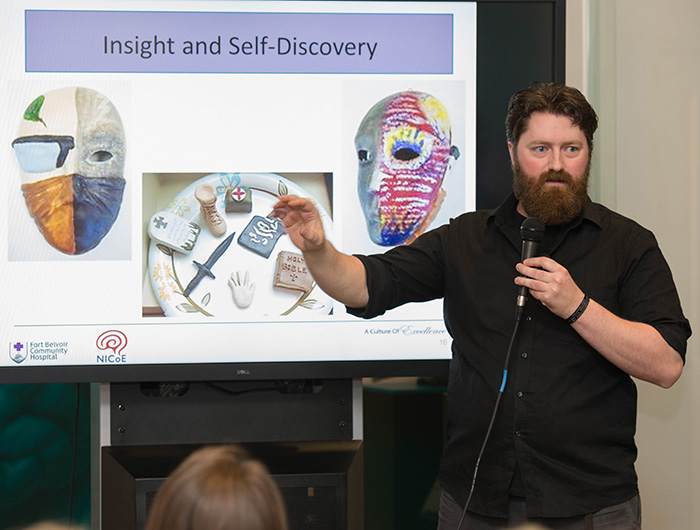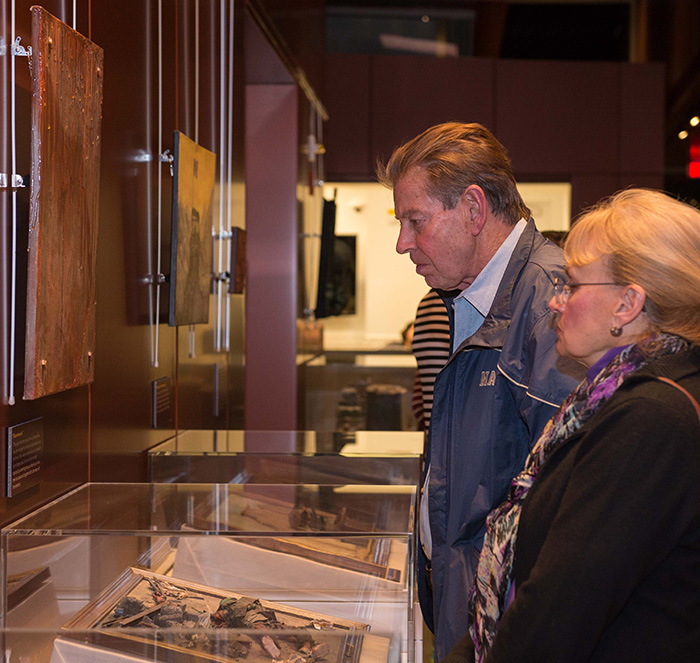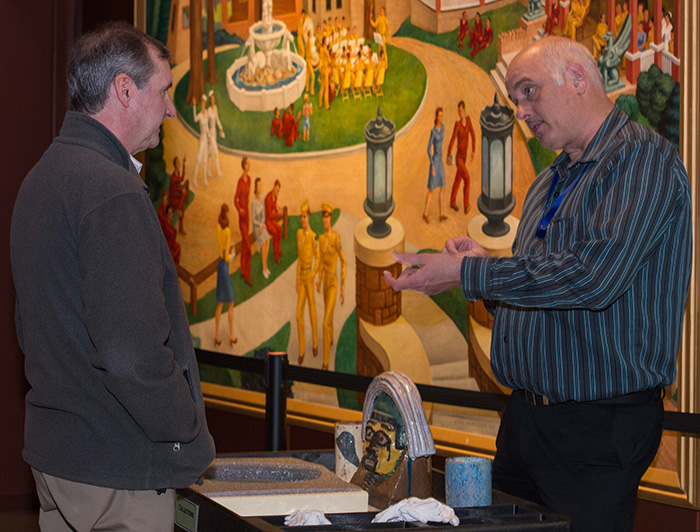Wounded Warrior, Art Therapist Share How Creating Art Helps Heal After Trauma
By Lauren Bigge
NMHM Public Affairs Coordinator
U.S. Army Sergeant Timothy "Mike" Goodrich (retired) and art therapist Jacqueline "Jackie" Jones told visitors at the National Museum of Health and Medicine (NMHM) on Jan. 23 about the process of wounded warrior healing through art creation by showcasing Goodrich’s exhibit titled "The Scars Remain." The exhibit, on display at NMHM through the end of February, is the result of Goodrich’s efforts during an art therapy program at Fort Belvoir Community Hospital's Intrepid Spirit One, the National Intrepid Center of Excellence satellite. Intrepid Spirit One supports active-duty service members in rehabilitative treatment for traumatic brain injury and psychological health conditions through interdisciplinary treatment.
Goodrich suffered career-ending trauma, including a traumatic brain injury, while serving as a psychological operations team sergeant in Iraq and Afghanistan. He pointed out to the audience the relief sculpture of his worn combat boots and clothing fragments spattered with his own blood, next to a medical syringe; it is titled "Evidence of True Faith and Allegiance." His boot strings and clothes were cut off at an aid station as medical personnel worked to save his life.
Earlier in treatment, he had created a sculpture which contained a boot print, blood stains and spent shell casings, as if to bring a piece of the battlefield home. He was relieved that Jones did not have a negative reaction to the sight of this piece, titled "The Exchange." "That was the ultimate test," Goodrich said. "I thought, ‘Okay, this will work out.’" Another sculpture of two sets of miniature combat boots on crates, holding up rifles topped by helmets, with folded flags across the toes, is titled "Greater Love Hath No Man." He said that it represents the "deaths of comrades and friends, not just other people who wore the same uniform as me; people I knew, people I trained with, people I spent life with."
"I needed [therapists] to understand what that [trauma] looked like to me," Goodrich explained. "That’s why I think the art therapy was really the breakthrough therapy for me. Nothing else got me where I needed to be, to move forward."
Jones explained that she began working with Goodrich in March 2014. "Art therapy has been a really significant part of his recovery," she said. "It has been shown to decrease stress and anxiety, and engaging in art-making is grounding. Aspects of creating art counteract the feelings of distress that would come up with processing negative subject matter, so [patients] often report that they are able to tolerate processing more at any given time than with talk alone. Also when you create art, you’re using all different parts of your brain, so it promotes neuroplasticity and brain growth and development."
The art created in the therapy process becomes a communications tool, Jones said; that is helpful because experiencing or recalling trauma causes the verbal areas of the brain to become inhibited. The areas of the brain that are active when processing trauma are active during the creation of art.
"Art therapy is wonderful to use because clues [from the subconscious] come up in the artwork and people are able to identify what they could not recall before, so we know that is significant and we know if we process through that, we get the reduction in flashbacks and nightmares," she said.
"Exhibiting "The Scars Remain" and hearing from the artist and art therapist help our visitors understand the value of military medicine’s investment in this rehabilitative process," said Andrea Schierkolk, NMHM public programs manager.
Prior to the program, staff members from the museum’s Historical Collections division showed visitors objects from World War I, World War II, and 20th century-era art and occupational therapy projects.
NMHM is an element of the Defense Health Agency Research and Development Directorate. Fort Belvoir Community Hospital is part of the National Capital Region Medical Directorate of the Defense Health Agency.
NMHM's Medical Museum Science Cafes are a regular series of informal talks that connect the mission of the Department of Defense museum with the public. NMHM was founded as the Army Medical Museum in 1862. For information on upcoming events, call 301-319-3303 or visit www.medicalmuseum.mil.







